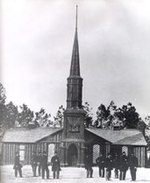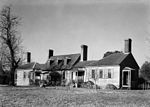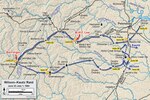The Battle of White Oak Road, also known as The Battle of Hatcher's Run, Gravelly Run, Boydton Plank Road, White Oak Ridge was fought on March 31, 1865, during the American Civil War at the end of the Richmond-Petersburg Campaign and in the beginning stage of the Appomattox Campaign. Along with the Battle of Dinwiddie Court House which was fought simultaneously on March 31, the battle involved the last offensive action by General Robert E. Lee's Confederate Army of Northern Virginia to stop the progress of Lieutenant General Ulysses S. Grant's Union Army (Army of the Potomac, Army of the Shenandoah and Army of the James). Grant's forces were moving to cut the remaining Confederate supply lines and to force the Confederates to extend their defensive lines at Petersburg, Virginia and Richmond, Virginia to the breaking point, if not to force them into a decisive open field battle.On March 29, 1865, the Union V Corps under Major General Gouverneur K. Warren moved to the end of the Confederates' White Oak Road Line, the far right flank of the Confederate defenses. At the conclusion of the Battle of Lewis's Farm on that day, Warren's corps took control of advance Confederate picket or outpost positions and occupied a segment of a key transportation and communication route, the Boydton Plank Road, at the junction of the Quaker Road. Warren's corps was the closest Union infantry unit to Major General Philip Sheridan's force which had moved about 4 miles (6.4 km) to Dinwiddie Court House, Virginia west of the end of the Confederate lines and just south of Five Forks, Virginia. Five Forks was an important road junction for control of the critical Confederate supply line of the South Side Railroad (sometimes shown as Southside Railroad).
Colonel Frederick Winthrop's brigade of Brigadier General Romeyn B. Ayres's division of the V Corps took a further advance position across Gravelly Run near the Confederate White Oak Road Line in torrential rain on March 30, 1865. Ayres was unaware of how close his men were settling in near the Confederate White Oak Road Line and that contrary to his observation and belief, the Confederate line extended beyond the end of his new position. This, and the separation between Ayres's corps and Sheridan's cavalry, were important factors when Ayres's troops were surprised by a Confederate attack the next day. Warren's corps, led by Brevet Major General Charles Griffin's First Division, counterattacked, pushed the Confederates back to their original lines, secured advanced positions and cut the Confederates access to direct communication with Pickett over White Oak Road and the Boydton Plank Road. After securing his position, Warren also was able to send units to outflank and drive off Pickett's forces which were in a position to inflict a serious defeat on Sheridan's troopers whom Pickett's force had pushed back that day at Dinwiddie Court House.
The battles at White Oak Road and Dinwiddie Court House, while initially successful for the Confederates, even a tactical victory at Dinwiddie, ultimately did not advance their lines or achieve their strategic objective of weakening and driving back the Union forces or separating Sheridan's force from support. The battles and their aftermath set the stage for the Confederate defeats and the collapse of Confederate lines at the Battle of Five Forks on the following day, April 1, 1865, and the Third Battle of Petersburg (also known as the Breakthrough at Petersburg) on April 2, 1865 and ultimately led to the surrender of Lee's Army of Northern Virginia after the Battle of Appomattox Court House, Virginia on April 9, 1865.








